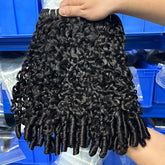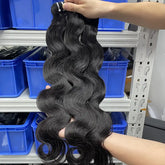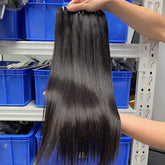Vietnamese Hair Production Process: 9 Key Steps Explained

The global demand for premium hair extensions and wigs is surging, especially within the black hair market, where consumers crave natural-looking, durable, and versatile options. Whether it’s to address hair loss or explore bold new styles, Vietnamese hair has risen to prominence as a top choice. Renowned for its exceptional quality, natural luster, and adaptability, Vietnamese hair is transforming the black hair extension and wig business.
What sets Vietnamese hair apart? It’s all about the meticulous production process that ensures every strand meets rigorous quality standards. In this blog post, we’ll uncover the nine key steps behind Vietnamese hair production, offering data-driven insights and the latest industry trends. Designed for wholesalers, retailers, and hairstylists, this guide also provides actionable tips to help you succeed in the fast-evolving black hair market. Let’s dive in!
Why Vietnamese Hair Dominates the Black Hair Market
Vietnamese hair stands out for its strength, durability, and natural shine—qualities that make it a perfect match for extensions and wigs. Unlike synthetic options, it can be styled, colored, and treated like natural hair, offering unmatched versatility. This is a game-changer for the black hair market, where consumers often seek products tailored to unique textures like kinky curly or afro-textured hair.
The numbers back this up: the global hair wig market is projected to grow from $2.68 billion in 2025 to $3.60 billion by 2032, with a compound annual growth rate (CAGR) of 4.26% (Fortune Business Insights). Asia Pacific, including Vietnam, is a powerhouse in this industry, supplying high-quality human hair to meet soaring demand. As the black hair market fuels this growth, understanding the Vietnamese hair production process is key for industry professionals looking to stay ahead.
The 9 Key Steps in the Vietnamese Hair Production Process
1. Sourcing: Ethical and Premium Hair Collection
The process starts with sourcing hair from donors, typically young women aged 18-25 from rural Vietnam. These women maintain their hair with natural products like herbs, oils, and rice water, avoiding chemical treatments. The result? Strong, healthy hair ideal for extensions and wigs. Ethical sourcing is a priority—factories ensure donors are fairly compensated and hair is donated voluntarily, resonating with socially conscious consumers in the black hair market.
2. Cleaning: Prepping the Hair
Next, the hair is thoroughly washed to remove impurities like dirt or natural oils. This step preserves its softness and shine, setting the stage for a high-quality final product.
3. Sorting: Consistency is Key
Hair is meticulously sorted by length, texture, and color to ensure uniformity. This is critical for creating consistent products—whether it’s straight hair for sleek styles or curly hair for voluminous looks—tailored to client specifications.
4. Processing: Tailoring Texture and Color
Depending on demand, hair may be treated to achieve specific textures (e.g., wavy, curly) or colors. Vietnamese factories use advanced techniques to maintain the hair’s natural integrity while offering customization. For the black hair market, this means producing in-demand textures like kinky curly or afro-textured hair.
5. Weaving: Building Durable Wefts
For weft extensions, hair is sewn onto a fabric strip, creating sturdy, easy-to-apply products. Wefts are a staple in the black hair market, prized for adding length and volume without compromising natural hair.
6. Creating Closures and Frontals: Seamless Hairlines
Closures and frontals are crafted by attaching hair to a lace or silk base, mimicking a natural hairline. These are essential for wigs and extensions, delivering a flawless, realistic finish that’s highly sought after in the black hair community.
7. Wig Making: Custom Creations
Wigs are made by attaching hair to a cap, often customized to suit individual tastes. From full lace to lace front wigs, Vietnamese hair ensures durability and a natural look, catering to the diverse styling needs of black consumers.
8. Quality Control: Excellence Guaranteed
Every product undergoes strict quality checks to ensure consistency in texture, color, and overall quality. Vietnamese factories’ dedication to excellence builds trust with wholesalers and retailers worldwide.
9. Packaging and Shipping: Reaching Global Markets
Finally, the finished products are packaged with care and shipped globally. With the hair extension market expanding, Vietnamese factories are well-equipped to meet demand, particularly in key markets like North America and Europe.
Industry Trends and Data-Driven Insights
Market Expansion: The global hair wig market’s projected 4.26% CAGR from 2025 to 2032 reflects growing demand for human hair products, with the black hair market playing a pivotal role (Fortune Business Insights). This is driven by a need for versatile styling and solutions for hair loss.
Ethical Sourcing: Consumers are prioritizing ethically sourced hair. Vietnamese factories that emphasize fair donor compensation and transparency are gaining favor, especially among socially responsible buyers.
Social Media Boom: Platforms like Instagram and TikTok are shaping hair trends, with influencers showcasing Vietnamese hair extensions and wigs. This visibility is boosting demand and opening doors for business collaborations.
Customization Demand: The ability to offer tailored textures and colors is a top trend. Vietnamese factories are responding by producing black hair market favorites like kinky curly and afro-textured options.
Key Takeaways and Actionable Tips
Wholesalers: Seek Vietnamese factories with customization capabilities to meet your clients’ specific needs. Prioritize suppliers committed to quality and ethical sourcing to stand out in a crowded market.
Retailers: Highlight Vietnamese hair’s benefits—durability, natural look, and versatility—to your customers. Promote its ethical origins to attract conscious shoppers.
Hairstylists: Keep up with trends and experiment with Vietnamese hair textures to offer clients fresh, personalized styles. Partner with influencers or share your work online to grow your clientele.
Vietnamese hair is revolutionizing the black hair extension and wig business with its superior quality, versatility, and ethical production. By mastering these nine key steps, wholesalers, retailers, and hairstylists can tap into a booming market fueled by innovation and consumer demand. As the industry evolves, Vietnamese hair is set to remain a leader, delivering natural, durable solutions for years to come







